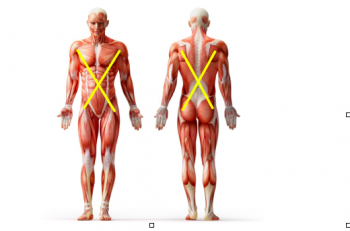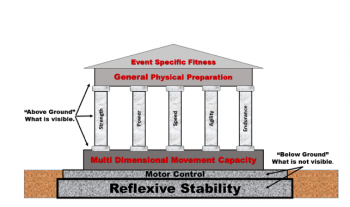A Case for Using the Original Strength Screen and Assessment
Oct 23, 2016

And now, a guest article from OS Instructor, Mark Shropshire. IF you've ever wondered about using the OSSA, check this out!
This summer I was approached by a division 1 women’s lacrosse athlete who came to me 5 weeks before she planned on leaving for college. She needed to pass a battery of fitness tests in order to play her senior year. For the previous 3 years she had worked on her speed and agility at a different facility than mine. The focus of her training was to pass 3 specific running tests that had historically been difficult for her. “I feel like I run out of gas no matter what I do.” She had yet to pass any of the running tests in her time as a collegiate athlete. In the past this young lady was able to earn playing time because of her superior stick skills and game awareness. This year however there was a philosophical shift at her school and it was communicated to the players that in order to play, you had to pass the fitness tests.
With 35 days before she left for school we began our training. Our plan was to work together twice per week for an hour each session. As with every athlete I work with, we began with an evaluation. Some would say I am overzealous with my evaluations. I like to think I am an evaluation enthusiast. To the best of my ability, I don’t leave much to chance. After some basic measurements of height, weight and sit and reach I took a look at her strength using manual muscle testing. She presented fairly strong and symmetrical. Basic athletic tests revealed nothing spectacular…..nothing was leading me to understand why she was struggling with her tests. Last, I took her though the Original Strength Screen and Assessment or OSSA™. For those unfamiliar with the OSSA™ it consists of 3 baseline reflexive movements (the screen) and 6 assessments based off the Original Strength® RESETS. (The resets are introduced in the “Pressing RESET” workshop. OSSA™ is covered during “PRO RESET” workshops) All in all, it provides a window into how well-connected a person is from fingers to toes.
Ultimately, it was the OSSA™ that showed me exactly what issues she was facing. My problem up to that point was that I had not gone deep enough with the evaluation process. Nothing up to that point gave me a “why” answer to my question. The OSSA™ revealed that although she tested out as strong with a manual strength test, she was unable to put that strength together when tasked with total body reflexive movement.
In Original Strength® we refer to “X’s”….. a lot. If you are not sure what I am talking about please refer to the diagram below. We use the letter X to describe basic movement linkages between body parts. This phenomena is present throughout the entire body, both posterior and anterior. For the sake of simplicity, the right shoulder is connected to the left hip and the left shoulder is connected to the right hip. All you have to do to see this connectivity in action is go for a walk. You will automatically swing your right arm forward at the same time you take a step with your left leg. You can’t help it – it’s how you are designed to move.
The Anterior and Posterior “X”

Our issue, now made more evident via the OSSA™, became clear. What she had been doing before was trying to solve her running problem with more running. Though perhaps the intuitive choice to solve the issue, running wasn’t the answer. Because her “X” was not well-connected her movements were very inefficient. The result of this movement inefficiency was a level of metabolic fatigue that interfered with the successful completion of the running tests. The graphic below helps to illustrate the problem. She was looking for answers at the top of the house when the problem was the foundation. Without a solid foundation of reflexive stability and motor control, basic and certainly complex multidimensional movement is impaired at best and may predispose one to injury at worst. The bedrock of all human movement is reflexive stability and optimal motor control. The OSSA™ helps us to see exactly how solid our foundation is, or is not.

Over the next 5 weeks we utilized the Original Strength® RESETS in combination with her strength program. Sprints, agility and endurance training were NOT a part of her routine. Rather, we utilized a regimen that emphasized reflexive stability, motor control and general strength training as viewed through the lens of Original Strength Performance. The result? In 5 weeks of training she was able to pass 2 of her 3 tests upon returning to school.
Without the use of the OSSA™ to help identify where the breakdowns in her performance truly were, they would have been easy to miss. Standard assessment protocols of movement and athletic performance were not sensitive enough instruments to detect the underlying issues we were dealing with. In short, using a traditional approach to evaluation and program design would have failed her. This type of failure is not an option when my livelihood depends on my ability to accurately evaluate and program for deficiencies in athletic performance. This experience clearly demonstrates how invaluable the OSSA™ is when it comes to screening athletes and directing the training process.

MARK SHROPSHIRE, MS, ORIGINAL STRENGTH INSTRUCTOR, SFG, FMSII, CKFMS, OSSA, SHROPSHIRE SPORTS TRAINING
Mark Shropshire is the President and CEO of Shropshire Sports Training and has been training athletes and other professionals for more than 21 years. Prior to starting his own company in 2002, Mark was the Director of Cal Ripken Jr. Sports Acceleration in Columbia, Maryland from 1998 – 2002. He has been actively involved with Original Strength since 2012, and was promoted to instructor status in 2015 leading “OS Pressing RESET” workshops throughout the United States.
Mark has had the opportunity to work with a wide variety of athletes in his career which includes members of the NFL, MLB, NHL, Professional Soccer, US Special Forces, SWAT, US Marshals, US Secret Service, as well as numerous individuals who play at the Division I, II, and III collegiate levels. In addition to his certifications and continuous education on industry standards, Mark holds a Black Belt in Tae Kwon Do.
Comments (0)
Please login to comment.